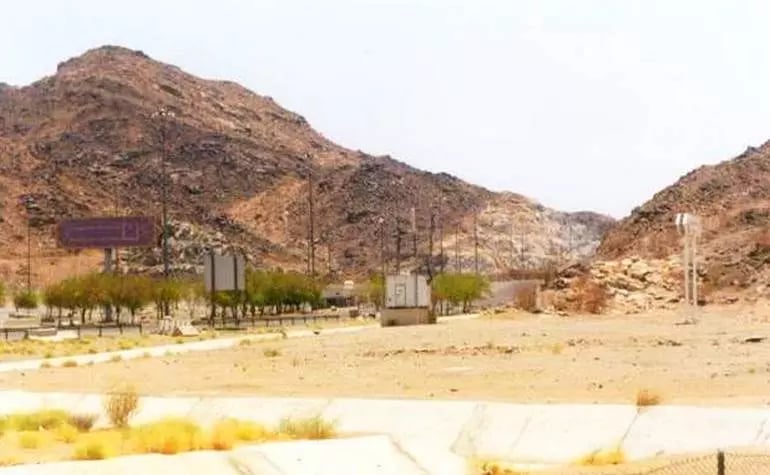Welcome, fellow travelers! Today, we embark on a journey to explore the enchanting Wadi e Muhassir in the heart of Makkah, Saudi Arabia. 🌄
Wadi e Muhassir, also known as the Valley of Muhassir, holds a profound historical significance in Islamic history. This oasis has witnessed pivotal events, dating back to the time of the Prophet Muhammad (PBUH).
MAKKAH
Me
12/17/20235 min read


Unlocking the Mysteries of Wadi e Muhassir: A Hidden Gem in Makkah, KSA
Introduction
Welcome, fellow travelers! Today, we embark on a journey to explore the enchanting Wadi e Muhassir in the heart of Makkah, Saudi Arabia. 🌄
Unveiling the Past: History of Wadi e Muhassir
Origin and Significance
Wadi Muhassar is situated between Mina and Muzdalifah. It is a Sunnah to walk briskly through this area when crossing between the two sites. It is also reported to be the location where the army of Abraha was destroyed as they marched towards Makkah, as mentioned in Surah al-Fil.
Wadi e Muhassir, also known as the Valley of Muhassir, is steeped in profound historical significance within Islamic history. This valley has been a witness to pivotal events, dating back to the era of the Prophet Muhammad (PBUH). The name "Muhassir" translates to "the one who causes restriction," reflecting the trials faced by the Prophet and his followers during their migration.
Prophet's Migration
As the Prophet Muhammad (PBUH) and his companions journeyed towards Makkah during the Hijrah, Wadi e Muhassir became a critical point of struggle. The terrain posed challenges, and the Prophet's perseverance in the face of adversity is etched into the very rocks and sands of this historic valley.
During the Hijrah, the migration of Prophet Muhammad (PBUH) and his companions towards Makkah, Wadi e Muhassir was a significant point of struggle. The challenging terrain underscored the Prophet's perseverance, leaving a spiritual imprint on the valley's rocks and sands.
Navigating Wadi e Muhassir: A Tourist's Guide 🗺️
Getting There
Location
Wadi e Muhassir is nestled in Makkah, accessible to both pilgrims and tourists. For specific route directions, ensure you follow the [recommended path] for a smooth journey.
Best Time to Visit
For an optimal experience, plan your visit during the mild seasons of spring or fall. The weather is pleasant, allowing you to explore the wadi comfortably.
Exploring the Wadi
1. Nature's Bounty
Marvel at the breathtaking natural beauty of Wadi e Muhassir. Surrounded by rugged mountains, the valley is adorned with lush greenery and occasional wildflowers. Don't forget your camera! 📸
2. Historical Markers
Embark on a journey through time as you encounter historical markers narrating the events that unfolded in this valley during the Prophet's migration.
3. Reflective Moments
Find a serene spot to reflect and connect with the spiritual energy that permeates the valley. Many visitors describe feeling a profound sense of tranquility.
Reviews from Fellow Travelers 🗣️
Testimonials
Ahmed, Dubai
"Wadi e Muhassir is a hidden gem! The blend of history and nature makes it a must-visit. I felt a deep connection to the past as I walked through the valley."
Sarah, USA
"The journey to Wadi e Muhassir was not just a physical one; it felt like a spiritual pilgrimage. The beauty of the landscape is matched only by the historical weight of the place."
Practical Tips for Your Journey 🧳
Essentials
Comfortable Footwear
The terrain can be uneven, so ensure you wear comfortable and sturdy shoes.
Water and Snacks
Stay hydrated, especially if you plan to explore the valley extensively. Pack some snacks to keep your energy up.
Cultural Sensitivity
Respect the historical and religious significance of the site. Dress modestly, and be mindful of the serenity of the surroundings.
The Incident of Abraha
Abraha al-Ashram, ruler of Yemen, constructed a grand church in Sana to divert Arab pilgrimage from the Kaaba to his church. After a man from the Banu Kinana tribe destroyed the church, Abraha vowed to destroy the Kaaba. He set out with a force, including elephants, but at Wadi e Muhassir, his largest elephant, Mehmud, refused to move toward the Kaaba. Allah then sent birds with pebbles, which struck down Abraha’s army, leading to Abraha’s downfall.
This event is described in Surah al-Fil, which recounts how the birds, carrying clay pebbles, pelted the invaders, leaving them like eaten fodder. This miraculous event further cemented the Kaaba's sanctity and spread its fame.
The Importance of the Year of the Elephant
The Year of the Elephant, 571 CE, is historically significant. The Holy Prophet was born 52-55 days after this event. During his Farewell Hajj, the Prophet passed through Wadi e Muhassir, moving swiftly due to the divine punishment that occurred there. He also collected pebbles here for the ritual of Rami.
The failed attempt by Abraha to destroy the Kaaba underscores its sanctity and Allah’s protection. This event remains a powerful reminder of Allah’s supremacy and continues to inspire millions of pilgrims.
Conclusion: A Journey Through Time and Terrain 🌍
As we conclude our exploration of Wadi e Muhassir, may your visit be filled with awe, reflection, and a deep appreciation for the history that resonates in every gust of wind and rustle of leaves. Plan your trip, embrace the experience, and let Wadi e Muhassir weave its magic on your soul. Safe travels! 🌟
FAQs
What is Wadi e Muhassir?
Wadi e Muhassir, also known as the Valley of Muhassir, is a historically significant valley located between Mina and Muzdalifah in Makkah. It is renowned for its association with the migration of Prophet Muhammad (PBUH) and the defeat of Abraha’s army.
Why is Wadi e Muhassir historically significant?
The valley is known for being the site where the army of Abraha was destroyed while attempting to invade Makkah, an event mentioned in Surah al-Fil. It also holds significance due to its association with the Prophet Muhammad's migration.
When is the best time to visit Wadi e Muhassir?
The best times to visit are during the mild seasons of spring or fall when the weather is pleasant for exploration.
How can I get to Wadi e Muhassir?
Wadi e Muhassir is accessible to both pilgrims and tourists in Makkah. It’s advisable to follow recommended routes for a smooth journey.
What should I bring when visiting Wadi e Muhassir?
Wear comfortable footwear suitable for uneven terrain, bring water and snacks to stay hydrated and energized, and dress modestly to respect the site’s cultural and historical significance.
What can I see at Wadi e Muhassir?
Visitors can marvel at the valley’s natural beauty, explore historical markers that narrate significant events, and find serene spots for reflection and connection with the valley’s spiritual energy.
What is the significance of the incident involving Abraha at Wadi e Muhassir?
Abraha al-Ashram’s attempt to destroy the Kaaba with his army was thwarted by birds sent by Allah, which pelted his forces with pebbles. This event is described in Surah al-Fil and signifies Allah’s protection of the Kaaba.
What was the Year of the Elephant, and why is it important?
The Year of the Elephant (571 CE) is the year when Abraha’s invasion occurred. It is significant because it is the year in which Prophet Muhammad (PBUH) was born shortly after, and it highlights the divine protection of the Kaaba.
What should visitors be mindful of while exploring Wadi e Muhassir?
Visitors should be respectful of the valley’s historical and religious significance, maintain cultural sensitivity, and ensure they follow local guidelines for behavior and attire.
What experiences have other travelers shared about Wadi e Muhassir?
Travelers have noted that Wadi e Muhassir is a hidden gem combining natural beauty with historical depth, offering a profound sense of connection to the past and a serene environment for reflection
Links
Socials
Subscribe to our newsletter


KSA Journeys is dedicated to showcasing the very best of Saudi Arabia’s destinations from its awe-inspiring natural landscapes to its rich cultural heritage. Our mission is to provide travelers with an easy, enjoyable, and immersive experience as they explore the Kingdom’s most iconic sites, hidden gems, and spiritual landmarks. Whether you're seeking adventure, relaxation, or cultural discovery, KSA Journeys is your trusted companion for unforgettable travel in Saudi Arabia.
Use full Links
Contact Us



